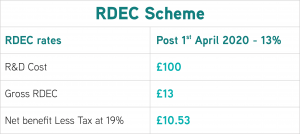


Dave Schorah
R&D Tax Team Leader
Due to the amount of money large companies are likely to be spending on R&D – the RDEC Scheme can be extremely beneficial! The Research and Development Expenditure Credit (RDEC) offers Large Enterprises (LE’s) a tax credit incentive of 13% on all qualifying R&D expenditure.
By HMRC definitions, a Large Enterprise is considered a company that has more than 500 full-time employees within the business or group, and either more than €100m turnover or €86m gross assets.
Businesses using the RDEC Scheme can claim 13% in tax relief on eligible R&D expenditure. This means that after Corporation Tax is deducted (as the credit is taxable), a claim is worth £10.53 for every £100 – the table below shows how this is worked out:

All Large Enterprises are eligible to claim the same percentage of tax relief, regardless of whether they’re loss-making or profit-making.
For the Financial Year 2018-19, 3310 claims were made by Large Enterprises using the RDEC Scheme. The average claim value for Large Enterprises was £632,000 and a total of £2.17 billion has been claimed so far.
Large Companies are likely to have an R&D function dedicated to producing new products, processes or services and therefore are likely to be spending large amounts on research and development activities. The total claim value can help fund future R&D investment and bring products or systems to market more quickly.
The benefit received from Large Company Scheme R&D Tax Relief can be accounted for above-the-line on the company’s profit and loss statement, meaning it can improve the profitability of the business’ accounts.
There are a wide range of costs that are eligible to be claimed via the RDEC Scheme, these include:
These costs have to be calculated carefully, ensuring a claim is only made for the proportion used for R&D purposes.
Within Large Enterprises it can be a complex and sometimes difficult task to keep track of R&D expenditure across multiple departments, projects and sometimes multiple businesses within a group.
We work closely with our large clients to identify all eligible expenditure across the business(es) and help to implement methodologies which make the process of claiming in future years much simpler.
In addition, our team work closely with technical staff to build robust evidentiary reports to support maximised R&D Tax claims. Contact us for further information.
Since 2022, HMRC’s Mandatory Random Enquiry Programme (MREP) has been reviewing R&D tax relief claims to reduce error and fraud. While the programme is effective in improving compliance, it has also caused a significant drop in SME claims. This article examines the impact of MREP on SME behaviour, explores why businesses are withdrawing from claiming, and questions whether the programme is supporting innovation or discouraging genuine R&D activity.

We take an in-depth look at the latest R&D Tax Credit Statistics, covering the period ending March 2024, highlighting key updates and trends in the R&D tax relief landscape. It covers changes to the SME and RDEC schemes, the introduction of new requirements such as the Claim Notification process, and developments in HMRC compliance through the Mandatory Random Enquiry Programme.

Assists organisations in accessing research and development grant funding across a range of UK and EU schemes and industry sectors.
Get In Touch